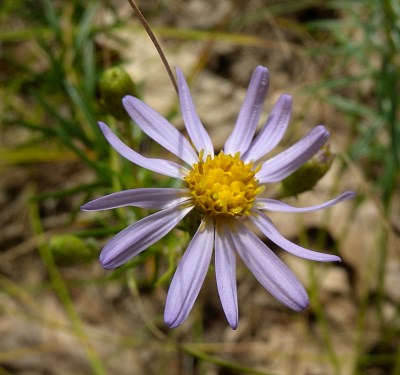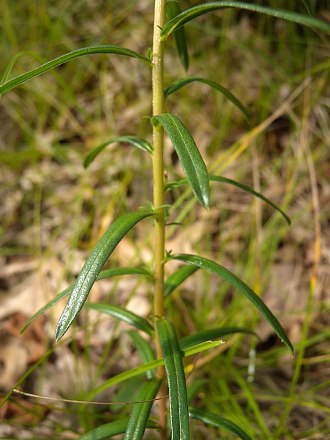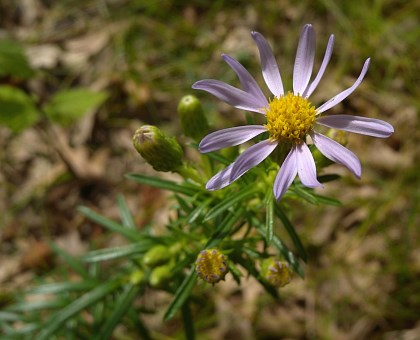Description: This perennial wildflower is ½–1½' tall, sending up one or more unbranched leafy stems from the root system. These stems are erect, ascending, or sprawling; they are light green, tan, or reddish brown, terete, and canescent. Along each stem, there are densely spaced alternate leaves that appear to be whorled (pointing in all directions). Individual leaves are ¾–1½" long and 1/8" (3 mm.) across; they are linear in shape, smooth along their margins, stiff, and sessile (or nearly so). The upper surfaces of the leaves are medium to dark green and glabrous, while their lower surfaces are pale green and canescent. Each leaf has a prominent midvein.

The central stem
terminates in a small cluster of flowerheads (sometimes only a single
flowerhead is produced, but there are usually more). Individual
flowerheads are born on unbranched peduncles about ½–2" long (rarely,
they are longer). Along each peduncle, there are small bracts up to ¼"
long that resemble the leaves, except they are much smaller in size.
The daisy-like flowerheads span ¾–1¼" across, consisting of 10-20 ray
florets and a similar number of disk florets. The petal-like rays are
lavender or pale blue-violet, while the tiny corollas of the disk
florets are bright yellow, later becoming orange-red. At the base of
each flowerhead, there are 4-5 series of appressed floral bracts.
Individual floral bracts are scale-like in appearance and linear-oblong
in shape; each of these bracts is medium green along the upper one-half
of its length, otherwise it is nearly white. The blooming period occurs
from early to mid-fall and lasts about 1 month. Both disk and ray
florets produce achenes. The small achenes are bullet-shaped and
pubescent; there is a small tuft of hairs at the apex of each achene.
For each tuft, the spreading inner hairs are long, while the outer
hairs
are short. The tufted achenes are distributed by the wind. The root
system forms a caudex with fibrous roots; sometimes, spreading rhizomes
are produced, from which vegetative offsets can develop.
The small achenes are bullet-shaped and
pubescent; there is a small tuft of hairs at the apex of each achene.
For each tuft, the spreading inner hairs are long, while the outer
hairs
are short. The tufted achenes are distributed by the wind. The root
system forms a caudex with fibrous roots; sometimes, spreading rhizomes
are produced, from which vegetative offsets can develop.
Cultivation:
The preference is full or partial sun, dry-mesic conditions, and an
acidic soil that is sandy or rocky. This wildflower can be cultivated
in rock gardens.
Range & Habitat:
The native Flax-Leaved Aster is occasional in the northern half of
Illinois, while
in the southern half of the state it is rare or absent (see Distribution
Map). Habitats include upland sand prairies, upland sandy
savannas, stabilized sand dunes, open rocky woodlands, rocky wooded
slopes, and sandstone glades. This wildflower is found in high quality
natural habitats with sparse ground cover. It benefits from occasional
wildfires in wooded areas, as this reduces the encroachment of woody
vegetation.
Faunal Associations:
The nectar and pollen of the flowerheads attract many kinds of insects,
including long-tongued bees, short-tongued bees, various flies,
butterflies, skippers, and beetles. Several bees are pollinator
specialists (oligoleges) of Aster spp. (asters): Andrena
asteris, Andrena asteroides, Andrena
hirticincta, Andrena nubecula, Andrena
simplex, Andrena solidaginis, and Colletes
simulans armata. Some of these bees are also oligoleges of Solidago
spp. (Goldenrods). Other insects feed on the leaves, flowers,
seeds, plant juices, stalks, or roots of Asters. These species include
the plant bug Plagiognathus cuneatus, the
leafhopper Macrosteles quadrilineatus, Exema
canadensis and other leaf beetles, the long-horned beetle Mecas
pergrata, several aphids (mainly Uroleucon spp.), and
caterpillars of the butterflies Chlosyne nycteis
(Silvery Checkerspot) and Phyciodes tharos (Pearl
Crescent). There are also many moth species whose caterpillars feed on asters (see Moth Table). Among vertebrate animals, the Ruffed Grouse and Wild
Turkey eat the leaves and seeds, while the Cottontail Rabbit and
White-Tailed Deer browse on the foliage. The White-Footed Mouse and
possibly other small rodents also eat the seeds.

Photographic
Location:
An upland sandy savanna at Hooper Branch Savanna Nature Preserve in
Iroquois County, Illinois.
Comments:
This wildflower has an elegant appearance. What distinguishes
Flax-Leaved Aster from species in the Aster genus are the tufted hairs
of its achenes: they consist of a combination of long and short hairs,
rather than hairs of uniform length. Nonetheless, it is sometimes
referred to as Aster linariifolius because of its
similarity to these species in other respects. Flax-Leaved Aster
superficially resembles Aster oblongifolius
(Aromatic Aster) to some extent, but it has unbranched stems, while the
latter species has abundantly branched stems. Because of its short
linear leaves, which are arranged in dense pseudo-whorls, Flax-Leaved
Aster is relatively easy to identify. Another common name of this
species is Stiff-Leaved Aster.